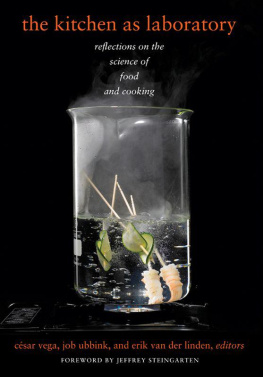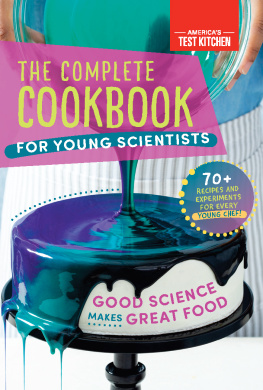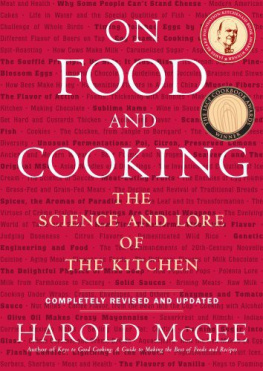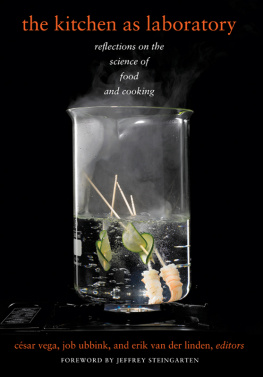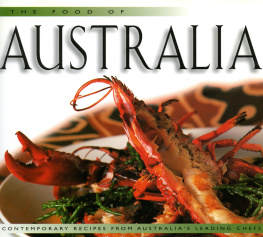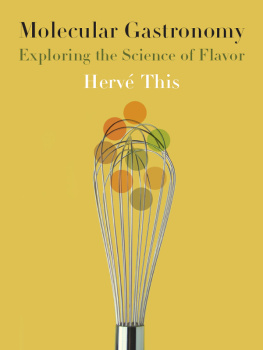the kitchen as laboratory
arts and traditions of the table: perspectives on culinary history
the kitchen as laboratory
reflections on the science of food and cooking
Edited by
Csar Vega, Job Ubbink, and Erik van der Linden
Foreword by Jeffrey Steingarten
COLUMBIA UNIVERSITY PRESS NEW YORK 
Columbia University Press
Publishers Since 1893
New York Chichester, West Sussex
cup.columbia.edu
Copyright 2012 Columbia University Press
All rights reserved
E-ISBN: 978-0-231-52692-0
Library of Congress Cataloging-in-Publication Data
The kitchen as laboratory : reflections on the science of food and cooking / edited by Csar Vega, Job Ubbink, and Erik van der Linden.
p. cm. (Arts and traditions of the table)
Includes bibliographical references and index.
ISBN 978-0-231-15344-7 (cloth : alk. paper)
1. FoodAnalysis. 2. FoodComposition. 3. Cooking. I. Vega, Csar. II. Ubbink, Job. III. Linden, Erik van der.
TX541.K55 2012
664.07dc23
2011029237
A Columbia University Press E-book.
CUP would be pleased to her about your reading experience with this e-book at cup-ebook@columbia.edu.
References to Internet Web sites (URLs) were accurate at the time of writing. Neither the editors nor Columbia University Press is responsible for URLs that may have expired or changed since the manuscript was prepared.
The use of recipes, preparation of food, testing of scientific concepts, and application of techniques described in this book must be done by only qualified people, and all possible safety precautions should be followed.
CONTENTS
CSAR VEGA, JOB UBBINK, AND ERIK VAN DER LINDEN I
JENNIFER KIMMEL
MALCOLM POVEY
CRISTINA DE LORENZO AND SERGIO LAGUARDA
CSAR VEGA AND PERE CASTELLS
ARIELLE JOHNSON, KENT KIRSHENBAUM, AND ANNE E. MCBRIDE
TIM J. FOSTER
CHRISTOS RITZOULIS
ALIAS A. KARIM AND RAJEEV BHAT
AKI KAMOZAWA AND H. ALEXANDER TALBOT
AMELIA FRAZIER AND RICHARD HARTEL
TIMOTHY KNIGHT
PIA SNITKJR AND LOUISE M. MORTENSEN
MARTIN LERSCH
MATT GOLDING
PETER WIERENGA, HELEN HOFSTEDE, ERIK VAN DER LINDEN, SIDNEY SCHUTTE, AND JONNIE BOER
JULIA MALDONADO-VALDERRAMA, PETER J. WILDE, AND MARA J. GLVEZ-RUIZ
ELKE SCHOLTEN AND MIRIAM PETERS
CSAR VEGA
THOMAS VILGIS
JOHN R. MITCHELL
PAULA VARELA AND SUSANA FISZMAN
ADAM BURBIDGE
CHRISTOPHER YOUNG AND NATHAN MYHRVOLD
NATALIE RUSS AND THOMAS VILGIS
JAN GROENEWOLD AND EKE MARIN
JOB UBBINK
JORGE RUIZ AND JULIA CALVARRO
THOMAS M. TONGUE JR.
LINE HOLLER MIELBY AND MICHAEL BOM FROST
HERV THIS
JUAN-CARLOS ARBOLEYA, DANIEL LASA, OSWALDO OLIVA, JAVIER VERGARA, AND ANDONI LUIS-ADURIZ
CSAR VEGA AND DAVID J. MCCLEMENTS
MICHAEL LAISKONIS
JEFFREY STEINGARTEN
Are we in the midst of a culinary revolution? Will cooking ever be the same? The answers are, respectively, yes and no. But what kind of revolution is this anyway? We cannot even agree on its name. We do not know who started it or when. And we do not know where it is heading or what the world will be like when it has run its course.
The previous revolution was launched in 1972 by Henri Gault, a French journalist and critic. In an article, he called it nouvelle cuisine and the name stuck, although by todays sophisticated branding standards, it was too general, ambiguous, unspecific, and bland. The term nouvelle cuisine, however, took off like a rocket and, as far as I know, was never seriously challenged except by people who challenge everything and those who considered the cuisine unrevolutionary and not nouvelle enough. French chefs at least as far back as Franois Pierre La Varenne in the seventeenth century have claimed to be revolutionizing French cooking through a process of simplification and purification. In 1973, in Vive la nouvelle cuisine franaise, Gault and fellow critic Christian Millau issued the Ten Commandments of nouvelle cuisine, of which only some specified a new way to think about food; one commandment, for example, recommended introducing air-conditioning into restaurant kitchens. But when a journalist aims for a catchy list of ten or twenty items, he or she must often pad the list to reach the magic number.
Gault and Millau were, in essence, reporting on how prominent young chefs were actually cooking in a new way. But a renewal of sorts had been bubbling through the old style of French haute cuisine in, for example, the cooking of the great Fernand Point. At La Pyramid, his restaurant in Valence, which he opened shortly after World War I, he trained chefs later associated with the nouvelle cuisine, particularly Paul Bocuse, Michel Gurard, and Alain Chapel. What made the young generations approach to cooking and food presentation a revolution was simply that a journalist called it a revolution and gave it a catchy title.
The problem is that the name of the current gastronomic revolution was coined by scientists instead of journalists, a mortal error. Nonetheless, the term they first produced, molecular gastronomy, was perfectly fine. For an appellation to be perfect, I suppose, it must include everything it names and exclude everything it does not. But names are rarely perfect. By this standard, the term molecular gastronomy is no worse than, say, the titles As You Like It and Alls Well That Ends Well, which indicate nothing about the story lines of the plays. Molecular gastronomy is a metaphor or, really, a metonymy. When my wife, Caron, was learning Mandarin in graduate school, she informed me that the modern Chinese word for a ballpoint pen is yuan zi bi, which means atomic pen. Now, do the Chinese people believe that there is a nuclear bomb inside each pen or that the ballpoint pen represents a novel exploitation of the atom? Of course not. For them, at that remote time when the ballpoint pen thrilled them with its novelty, atomic seemed the perfect word to express the idea of futuristic. Maybe we should call the current revolution atomic gastronomy.
In this handsome book, the editors suggest that we refer to this movement as science-based cooking. This term, however, reveals nothing about what went on in restaurants such as Ferran Adris El Bulli, where I had my first meal in 1998. What impressed me most about this meal was a plate arrangement that had the main ingredient in the center, enclosed in a circle of other ingredients, one of which was the inside of a tomatothe gel and seeds that French cookbooks have you squeeze out and discard from the start, but here presented intact. A day or two later, I asked Ferran how he had accomplished this, and he showed me, holding a long plum tomato in one hand and a knife in the other. After slicing off the top of the tomato, he ran the knife down the outside of the flesh (pericarp) wherever it was supported by one of four internal ribs (septa), cutting through each rib. The result was six or eight sections of tomato flesh that he pulled away, revealing four compartments (locular cavities) packed with gel and seeds that he removed, intact, with a spoon. Nobody else of whom I am aware has ever handled a tomato like this. (If you follow Adris method to separate the inside from the outside of a raw tomato and taste both, you will learn that the stunning umami flavor of the tomato lies mainly in the seeds and gel, as was later demonstrated by Heston Blumenthal.) Things change when you cook the tomato. Another example is Ferrans cauliflower couscous, which is created with a sharp, thin knife in one hand and a cauliflower floret in the other, held over a sheet of waxed paper. When you peel off the outer inch or slightly more of the cauliflower, it falls onto the paper in tiny white balls that resemble couscous. Great amusement ensues as the diners discover the delicious trick that has been played on them.

